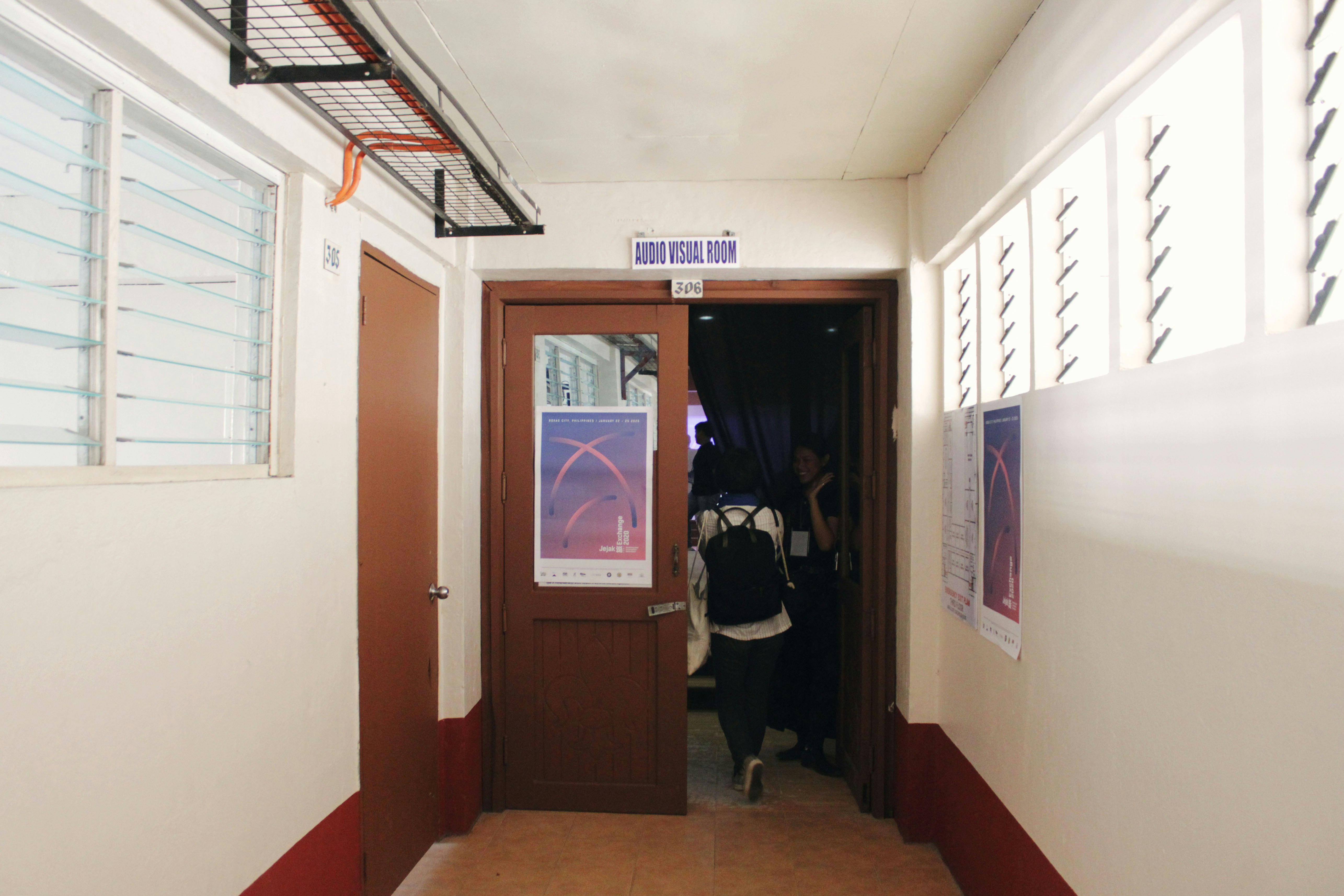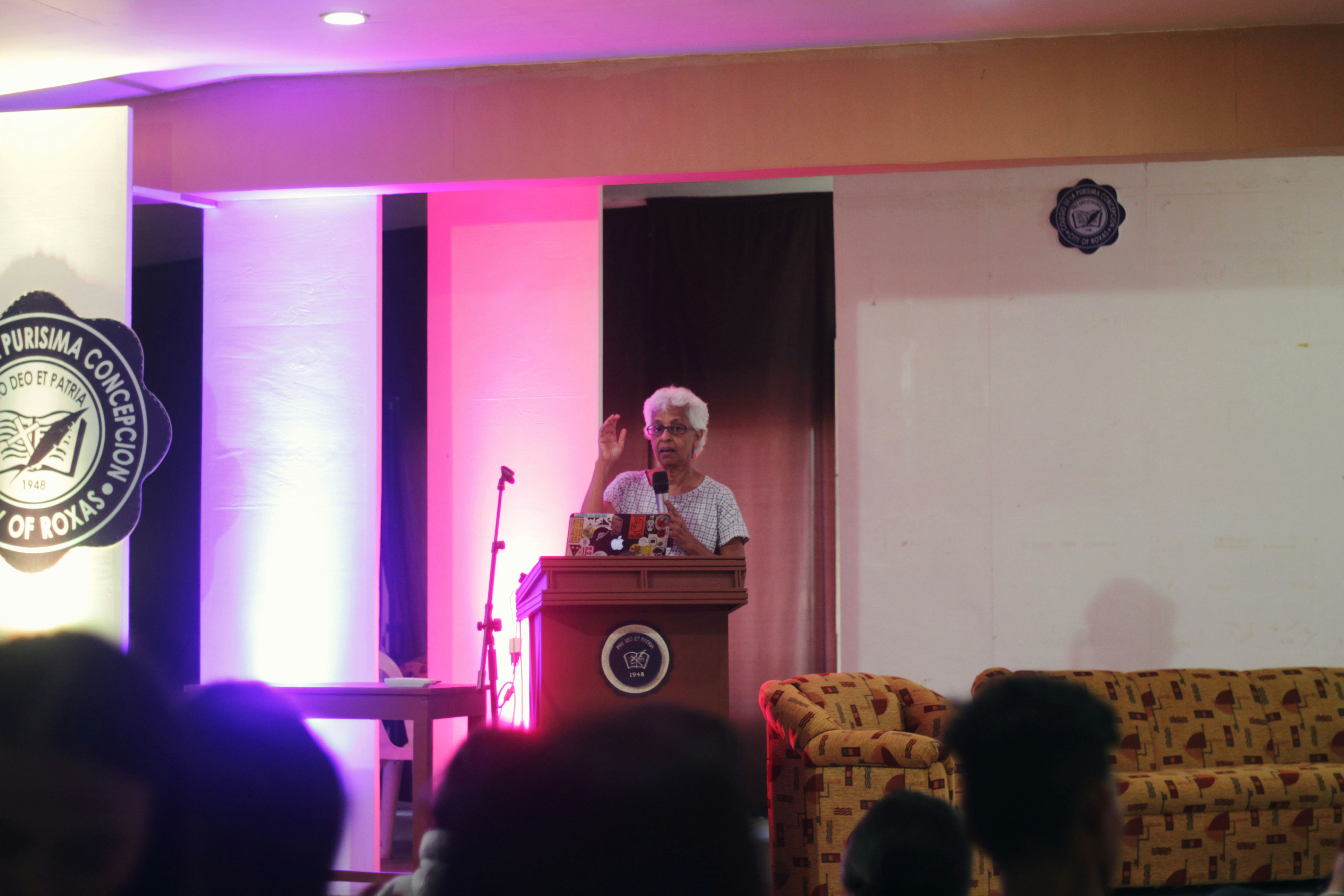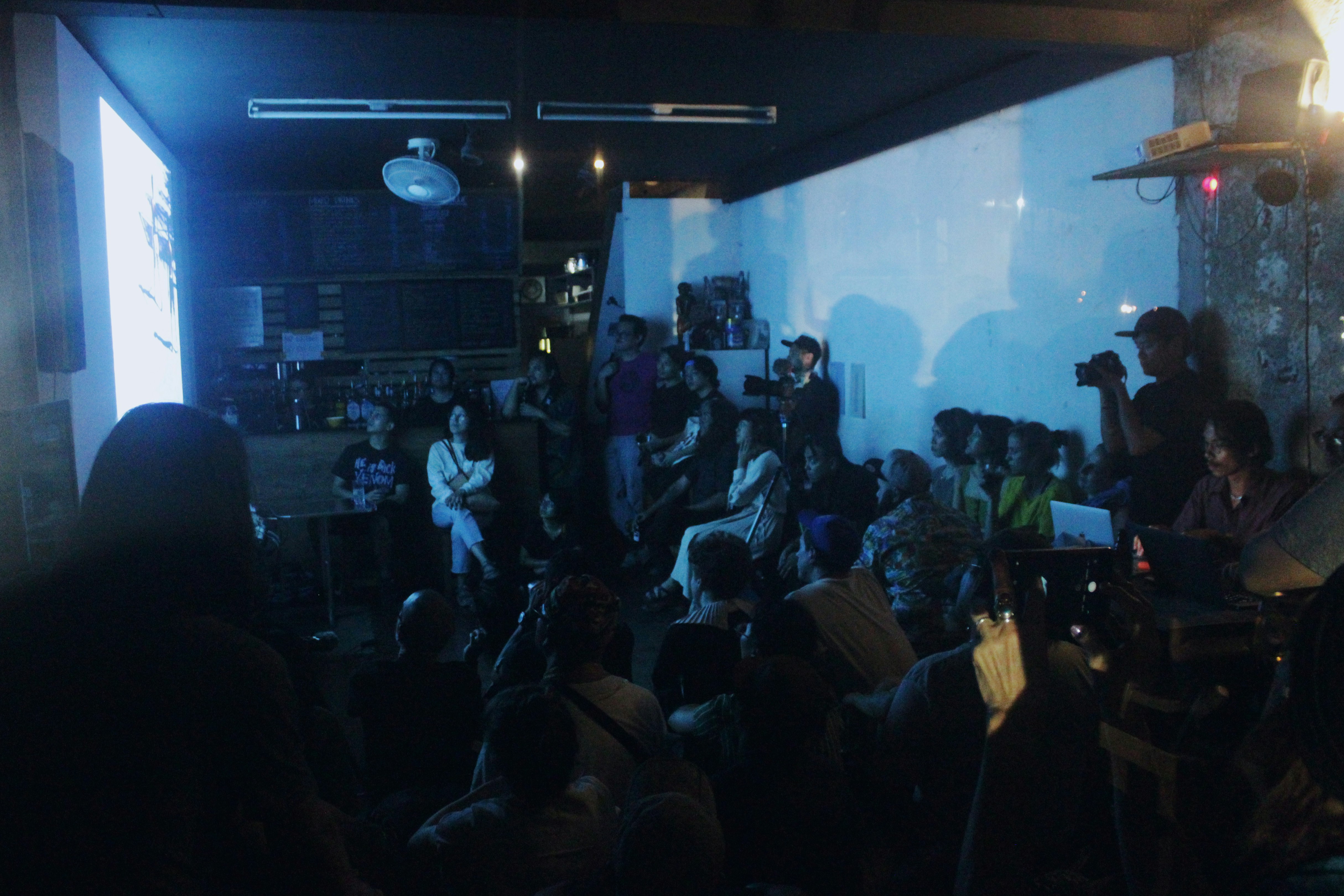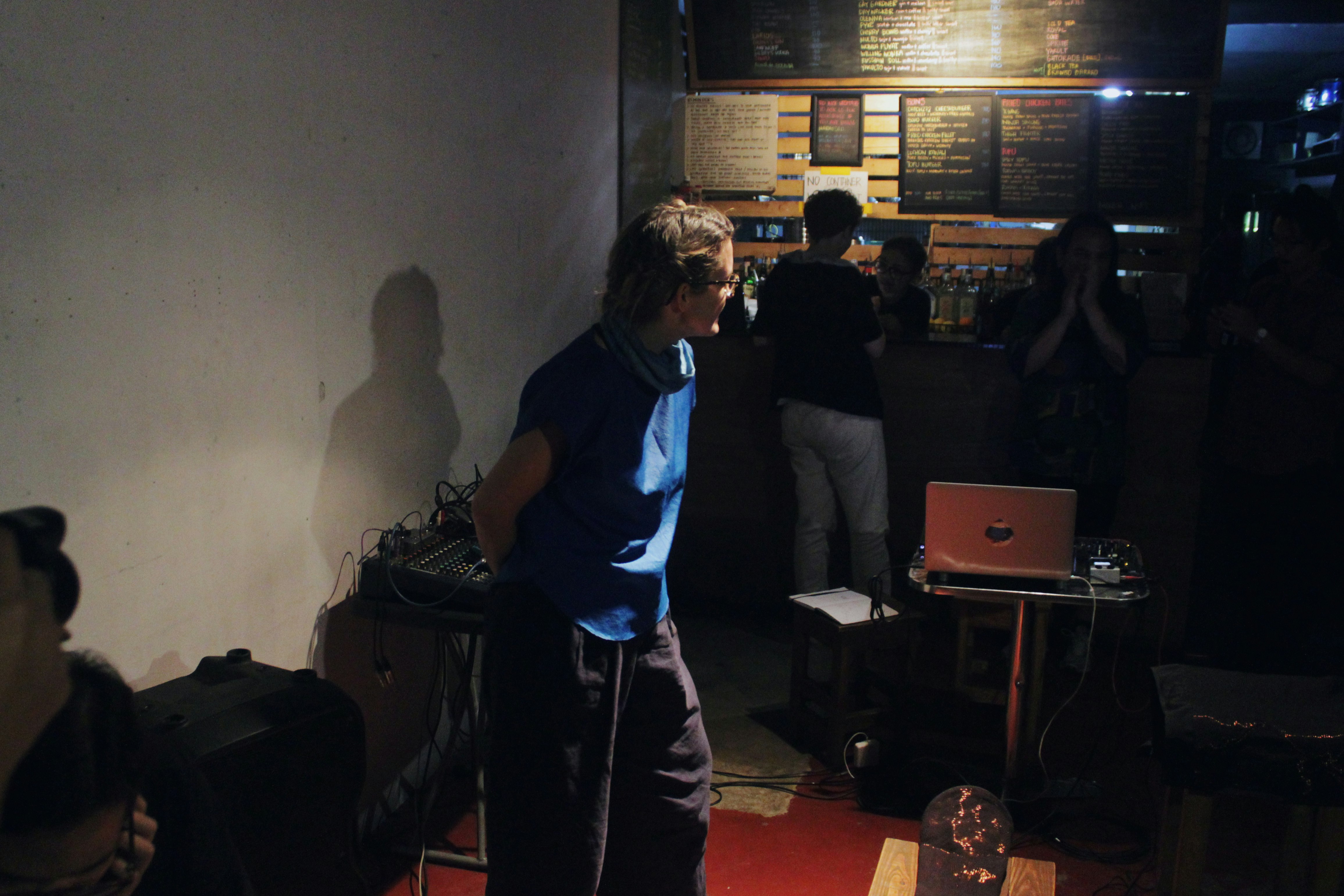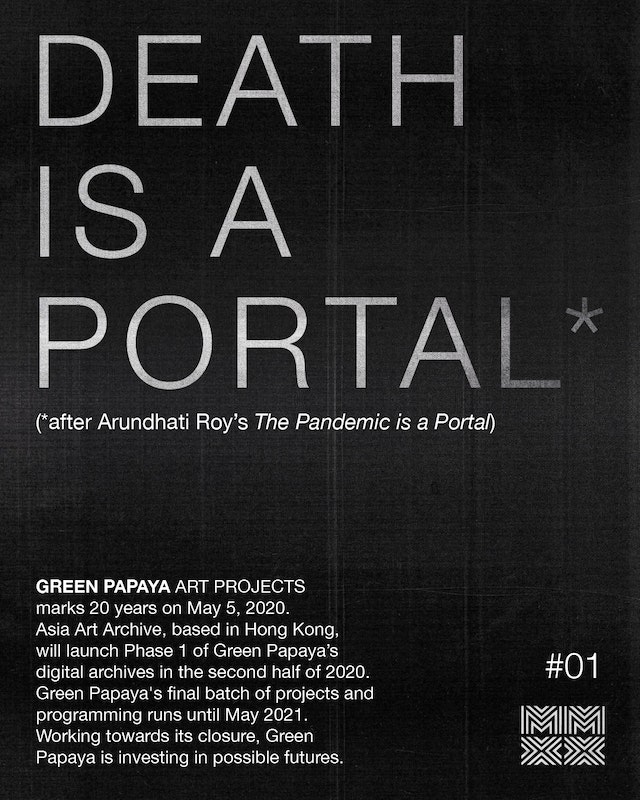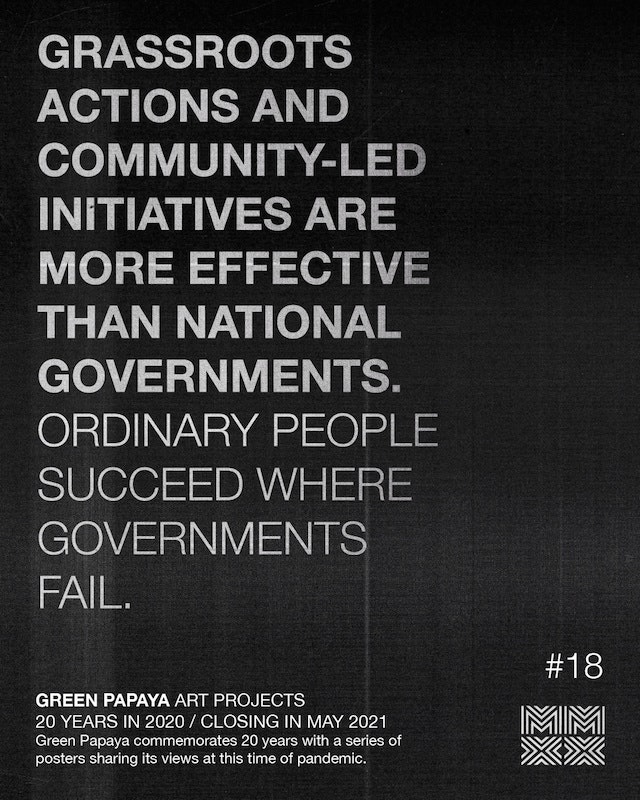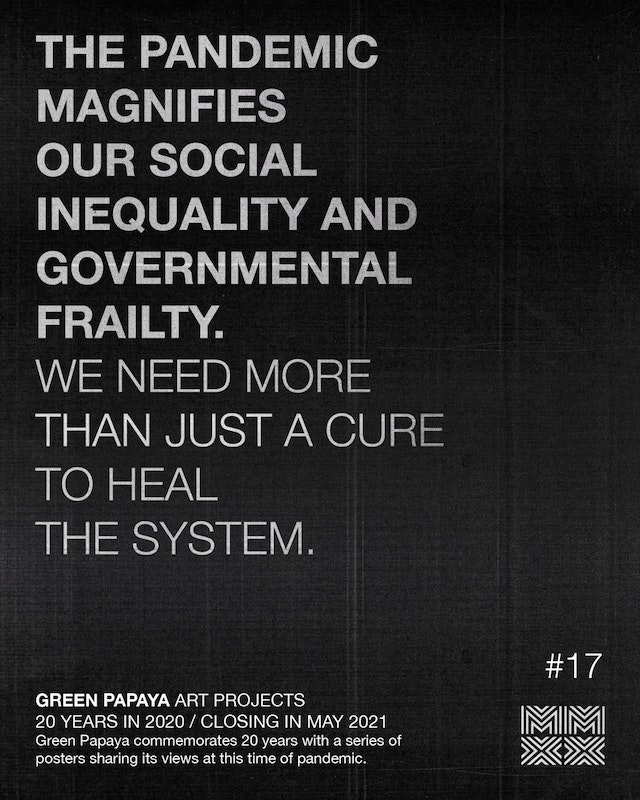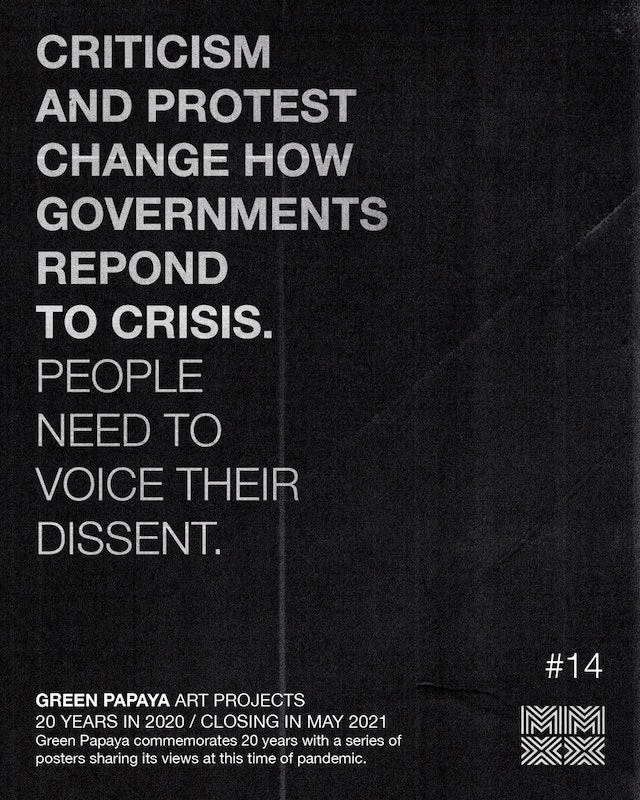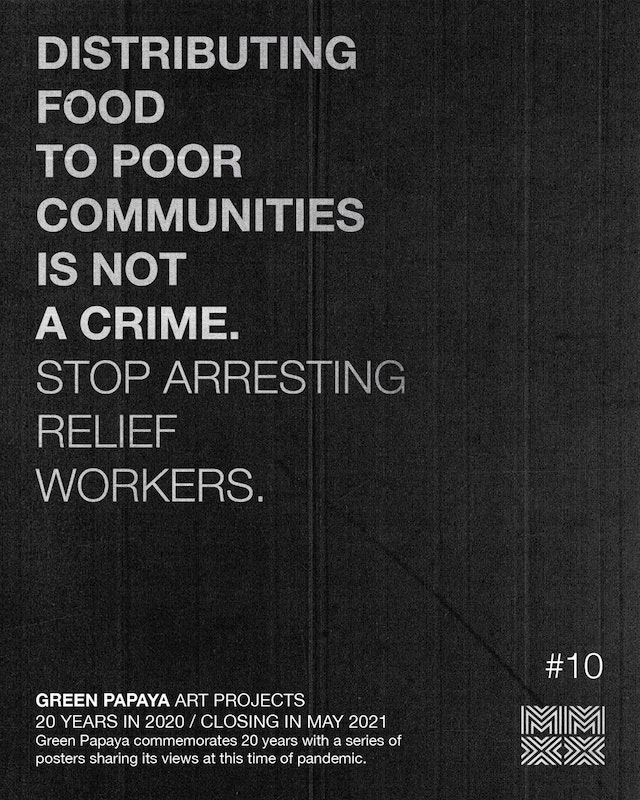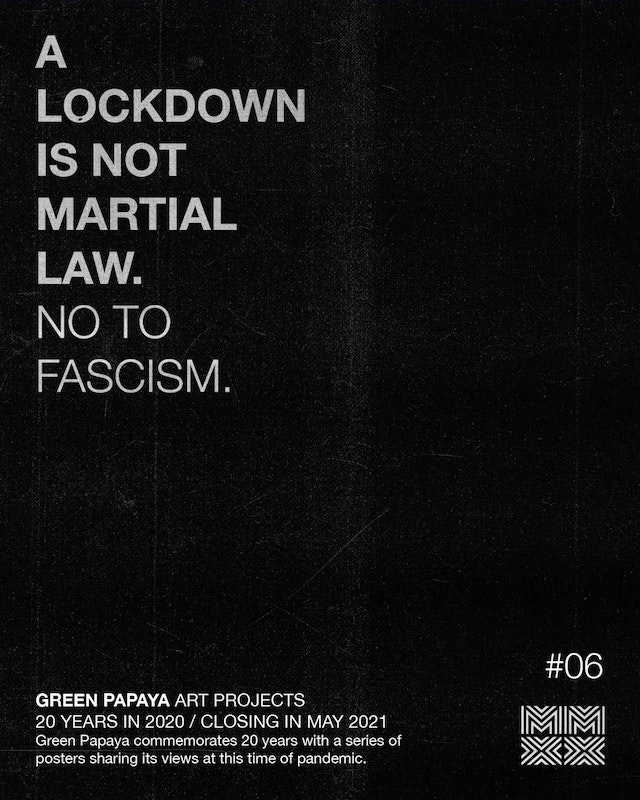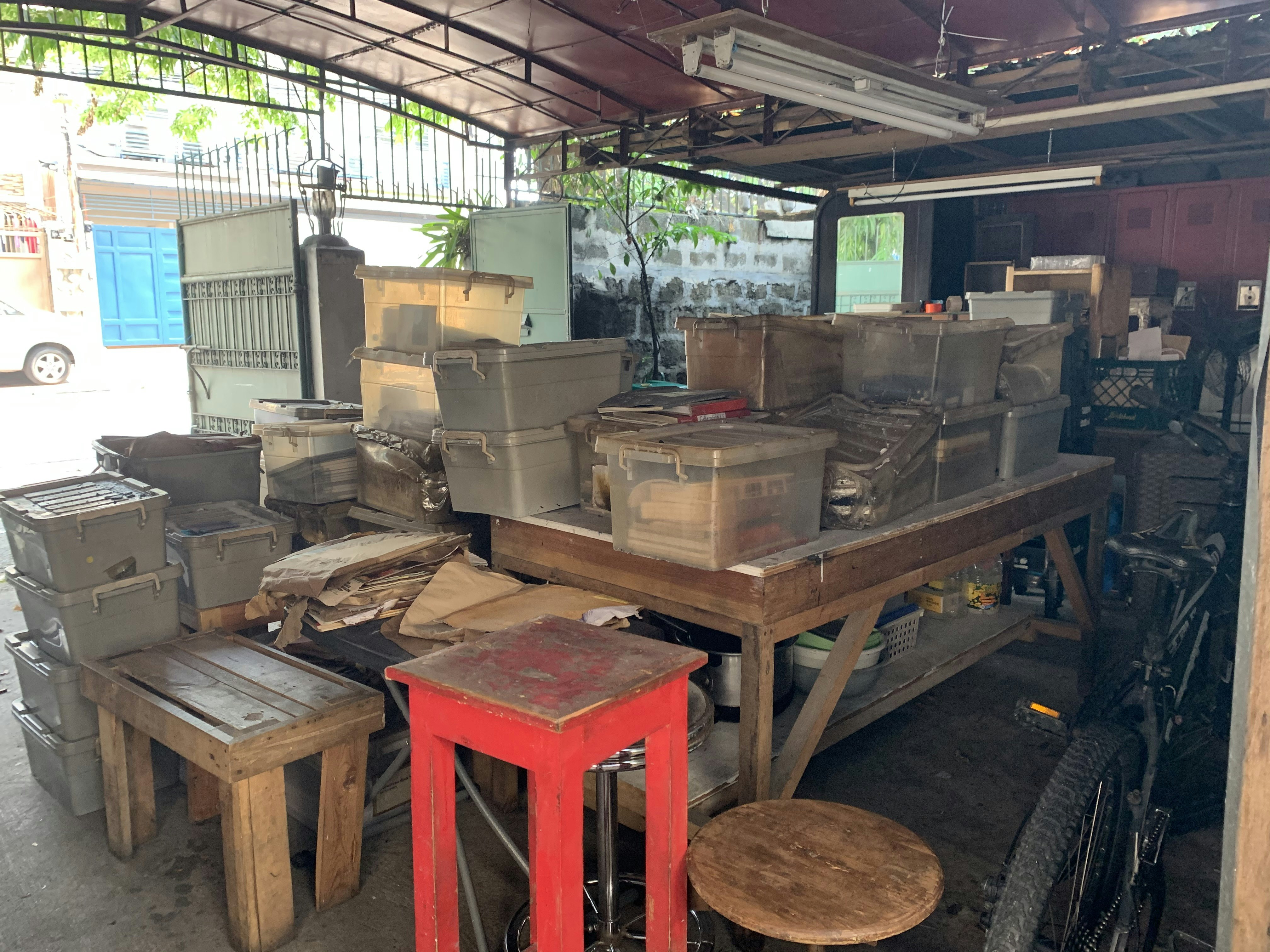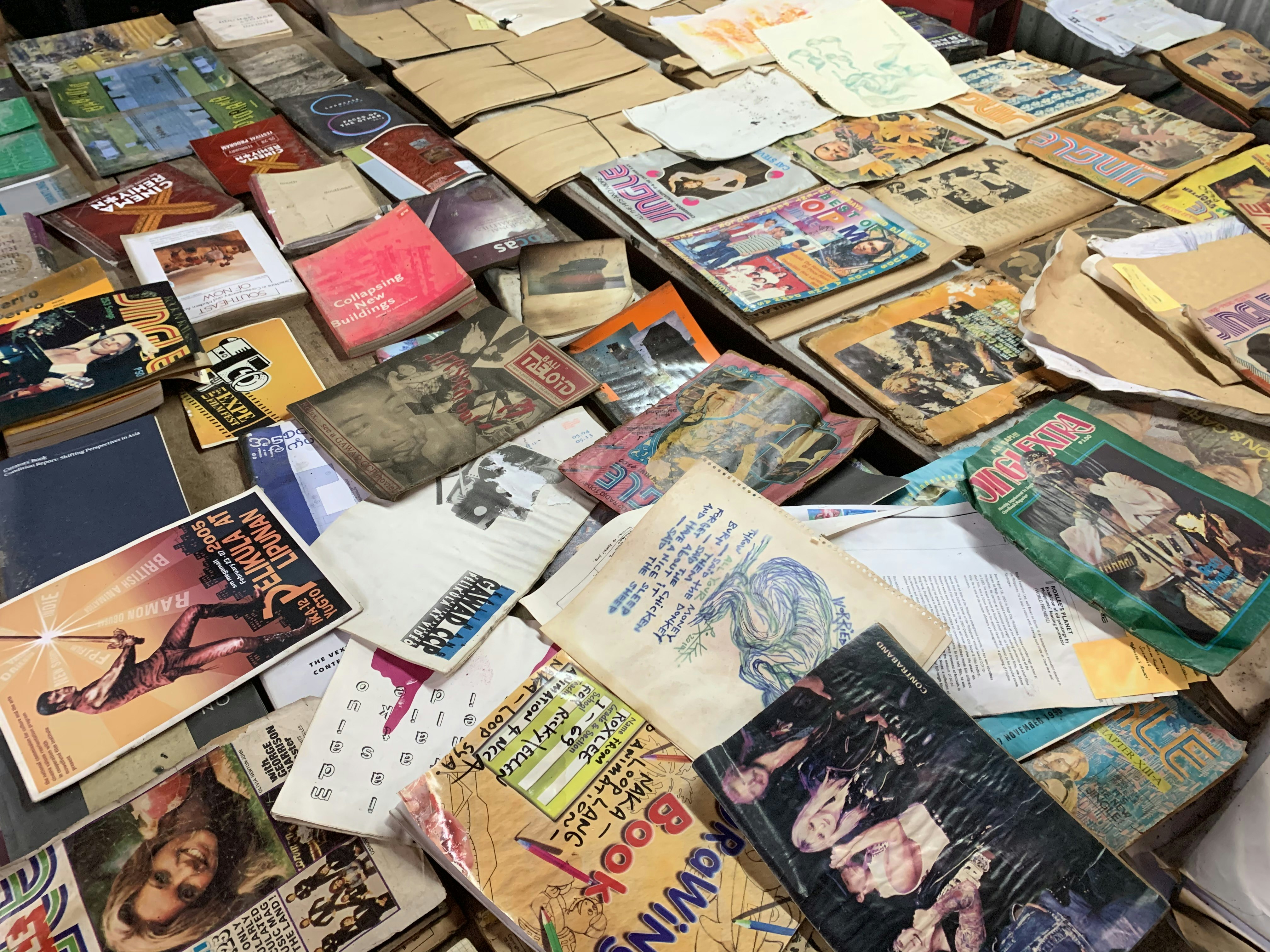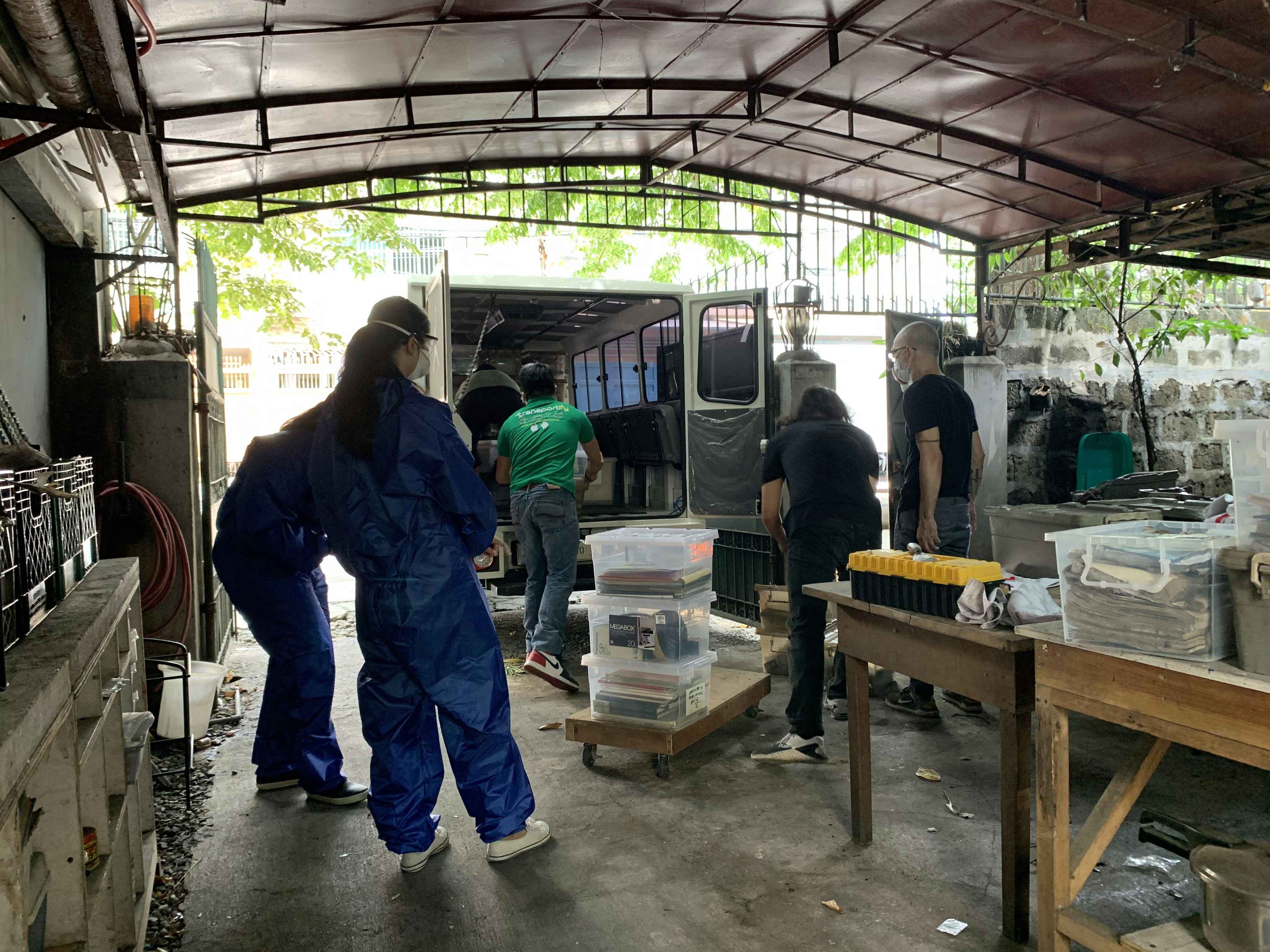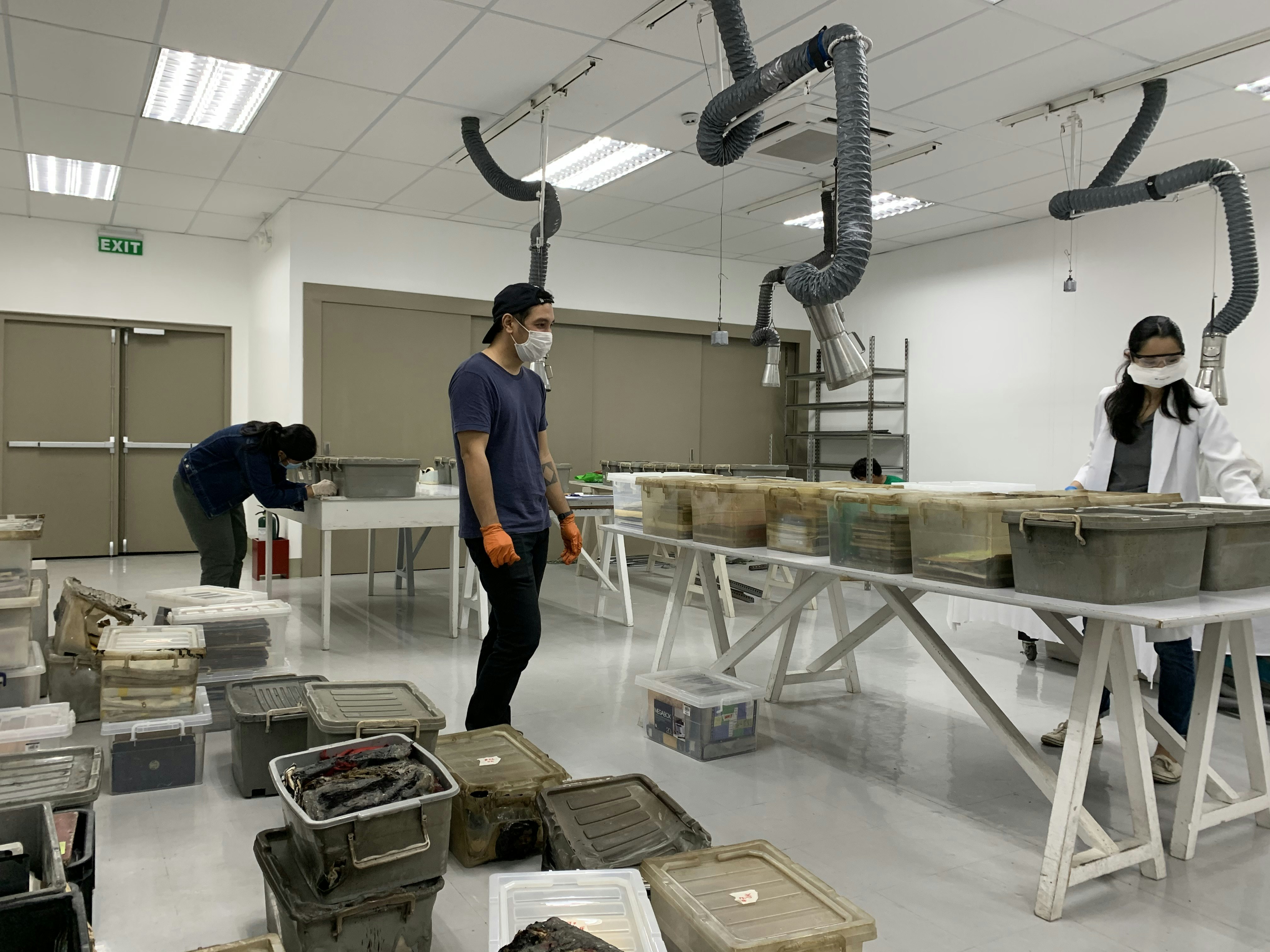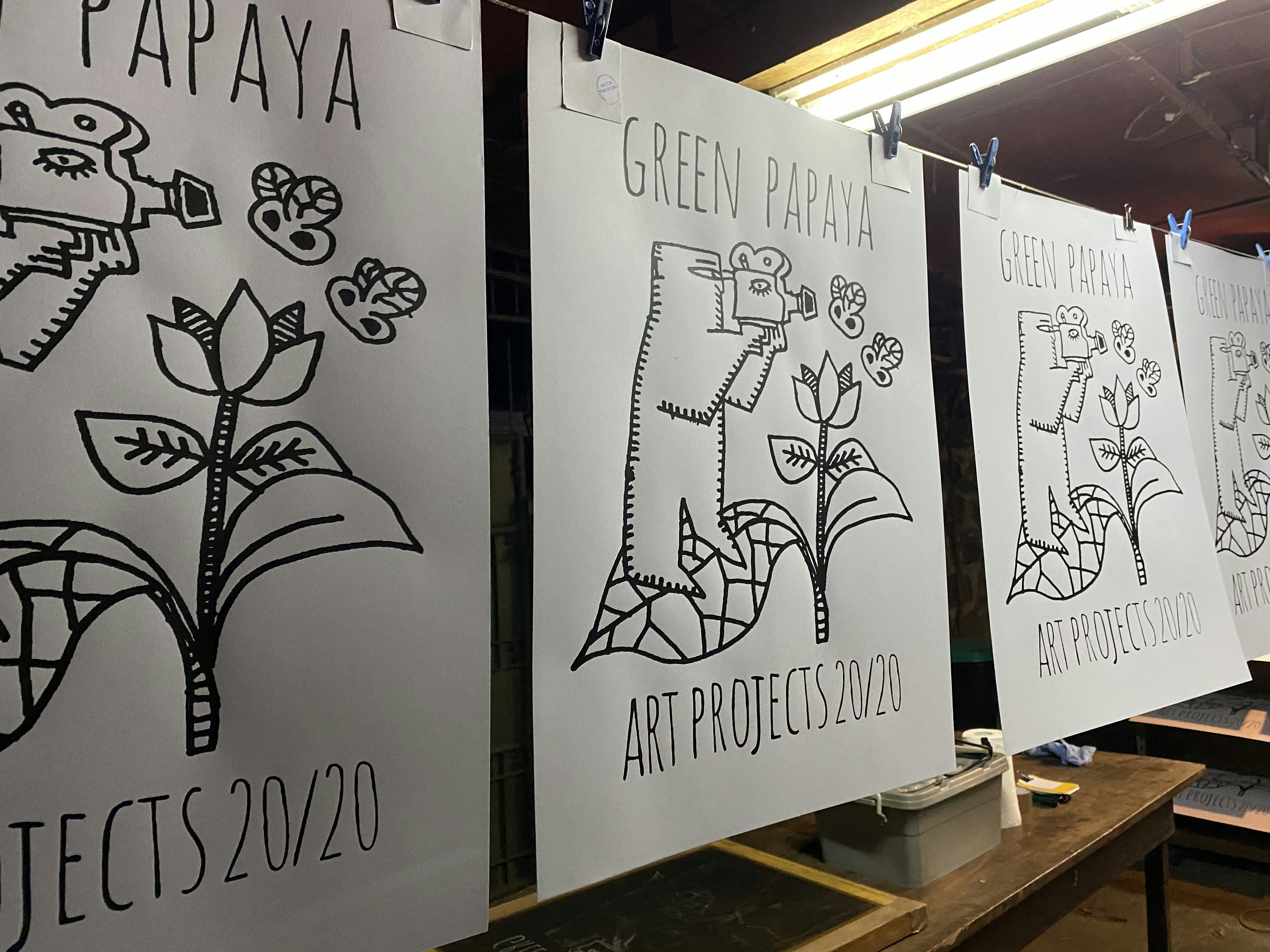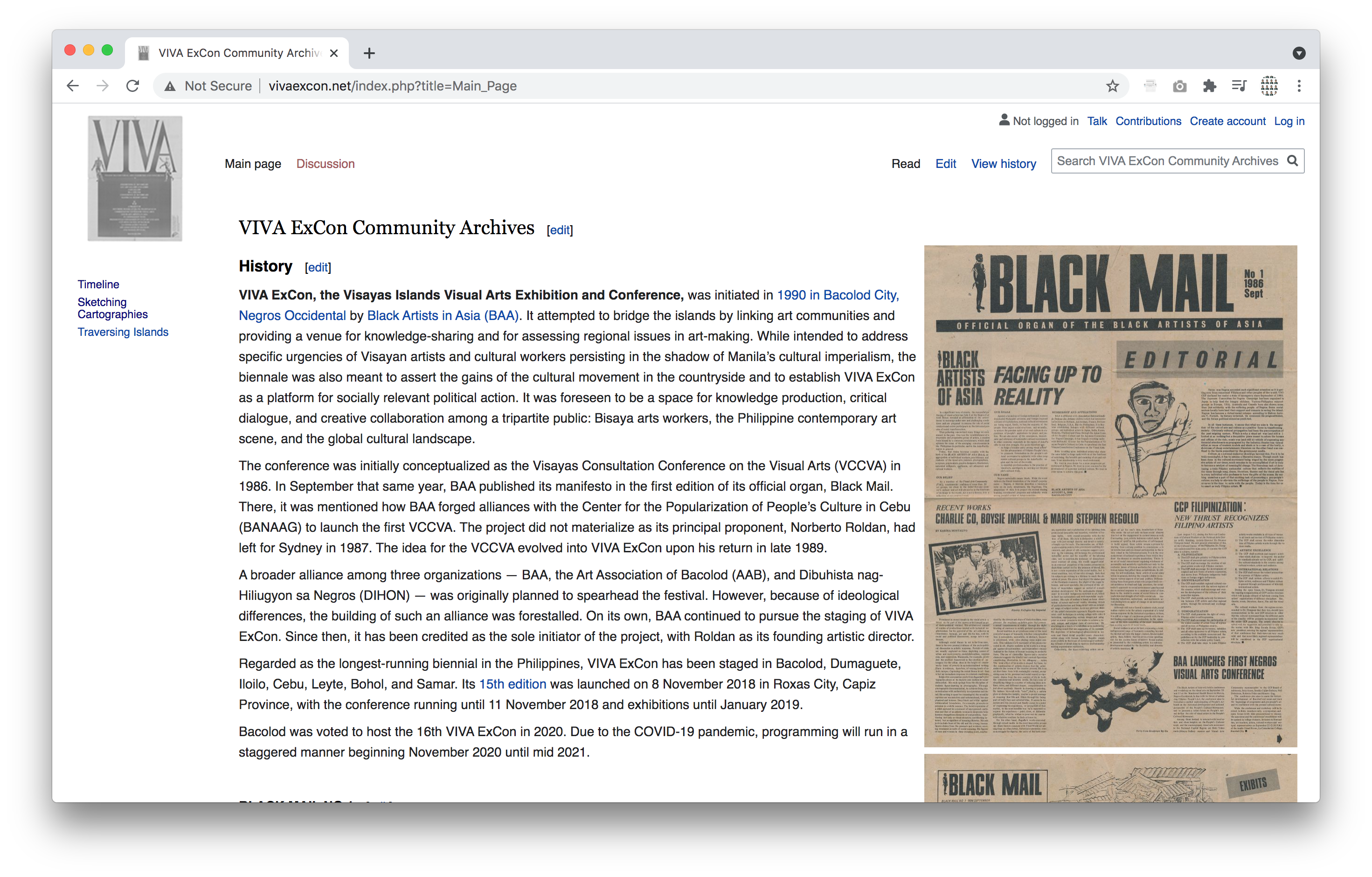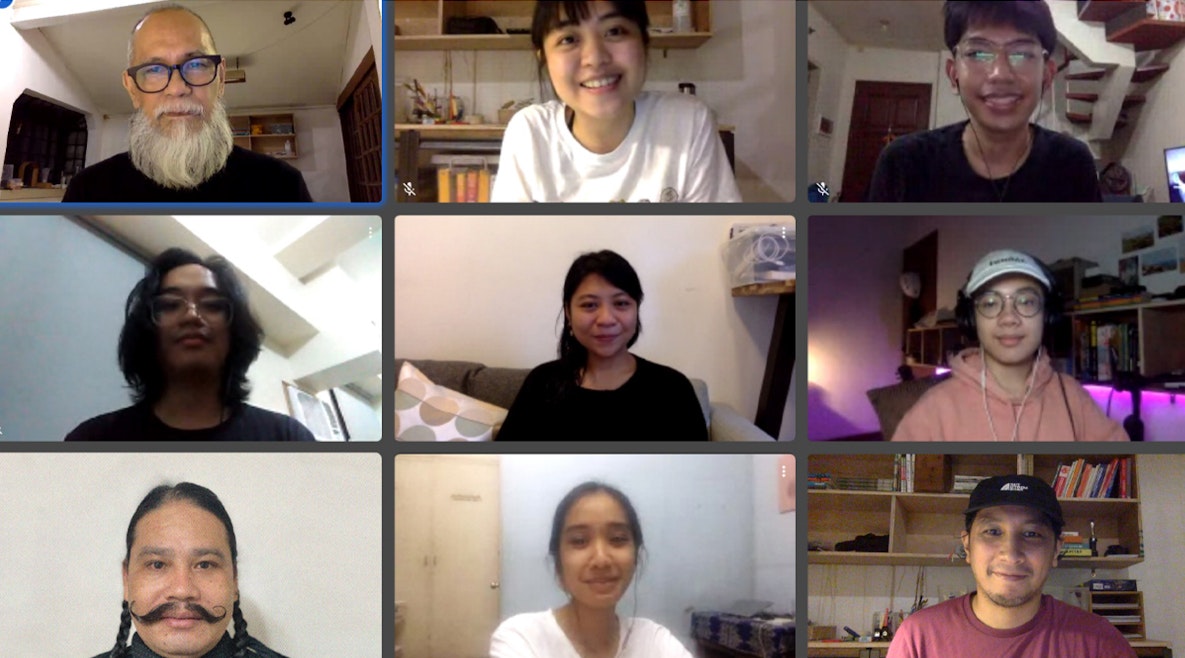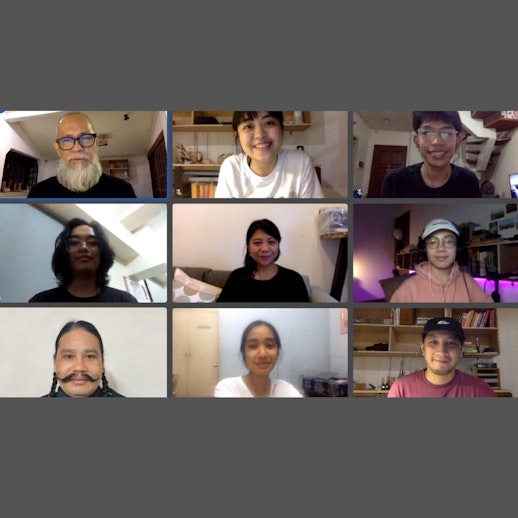The Trees That Grow Fragrant White Flowers are Gone
Green Papaya Art Projects
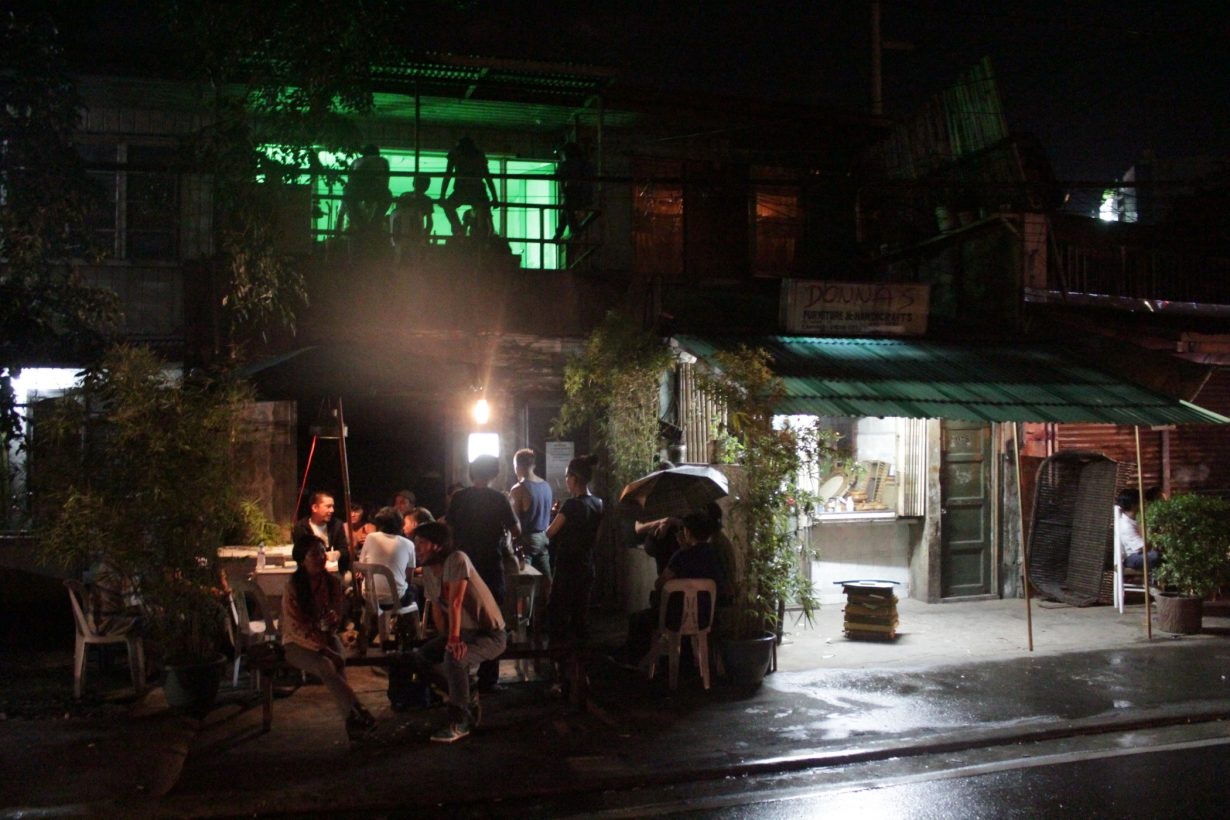
Green Papaya Art Projects in Quezon City. Courtesy Green Papaya Art Projects
After 20 years of operation, Green Papaya Art Projects planned to close in May 2020 due to co-founder Norberto 'Peewee' Roldan’s plans to relocate to Negros Island. This was an island in Visayas where he resided during the 1980s. However, many of Papaya’s plans were derailed and scrapped as a result of 2020’s shattering turn of events which—on top of the pandemic and the worsening political situation in the Philippines—saw Papaya confront a devastating fire as well as drastic changes in staff.
Founded on 1 May 2000 by Donna Miranda and Peewee, Papaya began as an exhibition space before shifting its focus to become a multidisciplinary platform organising screenings, gigs, discussions, performances, as well as off-site projects; initiating collaborations; encouraging research; developing special projects like publications; and facilitating residencies for local and international artists.
In August 2008, after having moved locations twice,1 Papaya moved into a two-storey structure in Kamuning, Quezon City. Sometime around October 2015, Catch272—a bar that many had regarded as a safe space for the LGBTQIA+ community and peasant rights groups—began to occupy Papaya’s ground floor. Meanwhile, Papaya continued to use the second floor for talks and screenings as well as a storage facility for most of its archives, keeping the rest at Green Papaya Extension, a space along Scout Rallos Street that also houses Papaya’s office.
In November 2016, Papaya went to Iloilo City to attend the Visayas Islands Visual Arts Exhibition and Conference (VIVA ExCon)—the longest-running artist-run biennial in the Philippines which Peewee co-initiated in 1990. During the plenary session customarily held following the series of conferences, Peewee’s bid to host the 15th edition of the biennial in his hometown of Roxas City in Capiz received the majority vote. Throughout 2017, Papaya was occupied with preparing for what would become the biggest project undertaken to date: VIVA ExCon Capiz 2018 featured numerous exhibitions, symposia, performances, screenings, workshops, parties, and other curatorial projects and programs spread across eight main venues around Roxas City from 8 November 2018 - 31 January 2019.
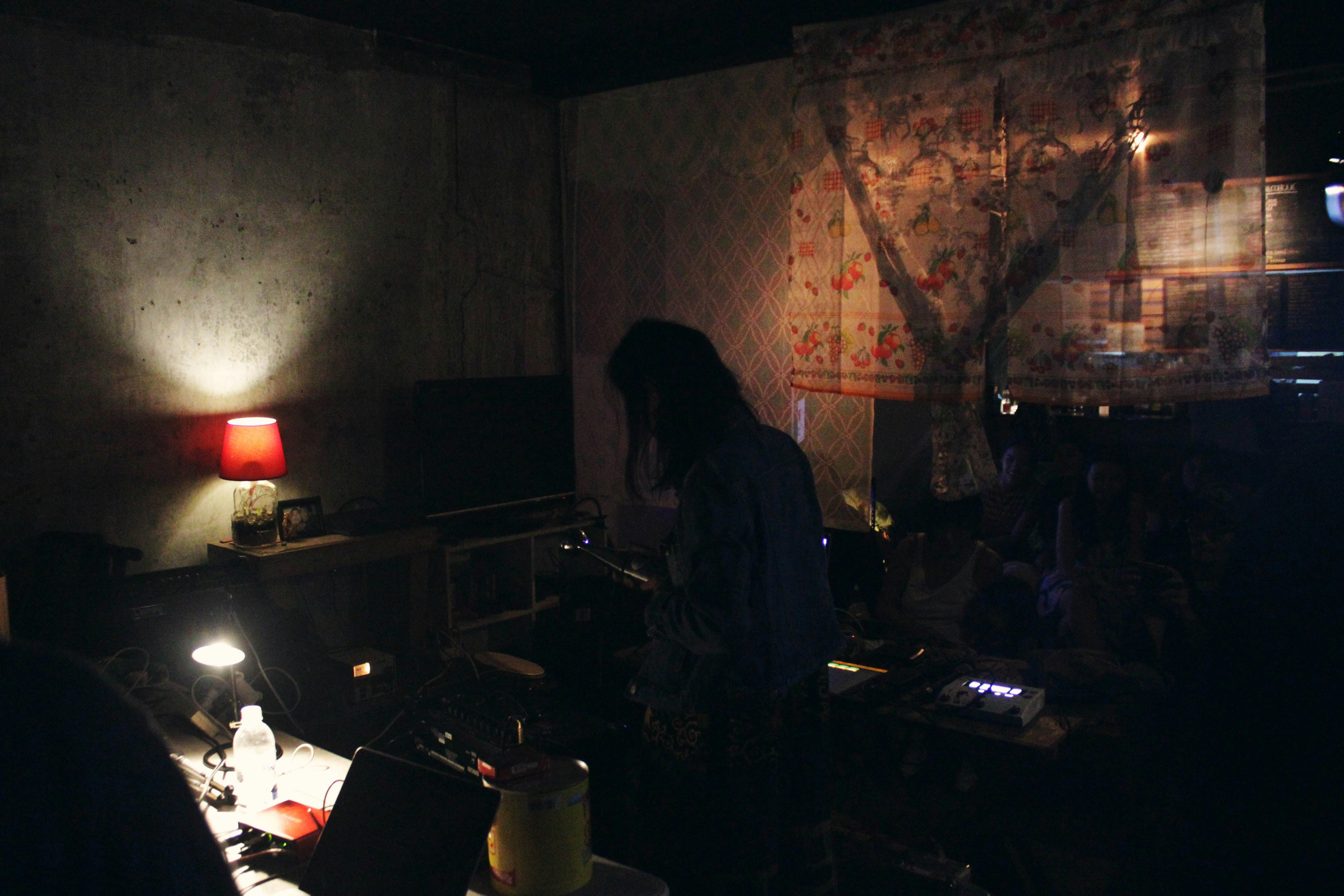
Alyana Cabral (a.k.a. Teenage Granny) performing for Kitchen Music.
In 2017, Peewee decided he would close Papaya in 2020 since it appeared that no one was ready to take over Papaya after this time. For Peewee, a 20-year run sounded like a complete journey, anyway. As such, Papaya started working closely with the Asia Art Archive (AAA) to archive the materials we had accumulated over the years.2 Following VIVA ExCon Capiz 2018, the appointed date of closing was moved to 2021 so that we would have more time to work on archiving and VIVA ExCon-related publications. In light of the pandemic and a fire that razed our space in June 2020, Papaya’s closing has been postponed indefinitely.3 Since then, in preparation for Papaya’s closing, we had aimed to get a section of our archives uploaded on the AAA website and to publish two books on VIVA ExCon—a catalogue for the 2018 edition and a ‘community archives’ book covering all prior editions—by 2020. Additionally, we had plans to mount an exhibition to commemorate our 20th anniversary.
What follows is a rough timeline of 2020 for Papaya, particularly of the numerous projects we initiated or participated in, along with several key events. From this, hopefully one may glean how Papaya adapted in response to the challenges we had faced.
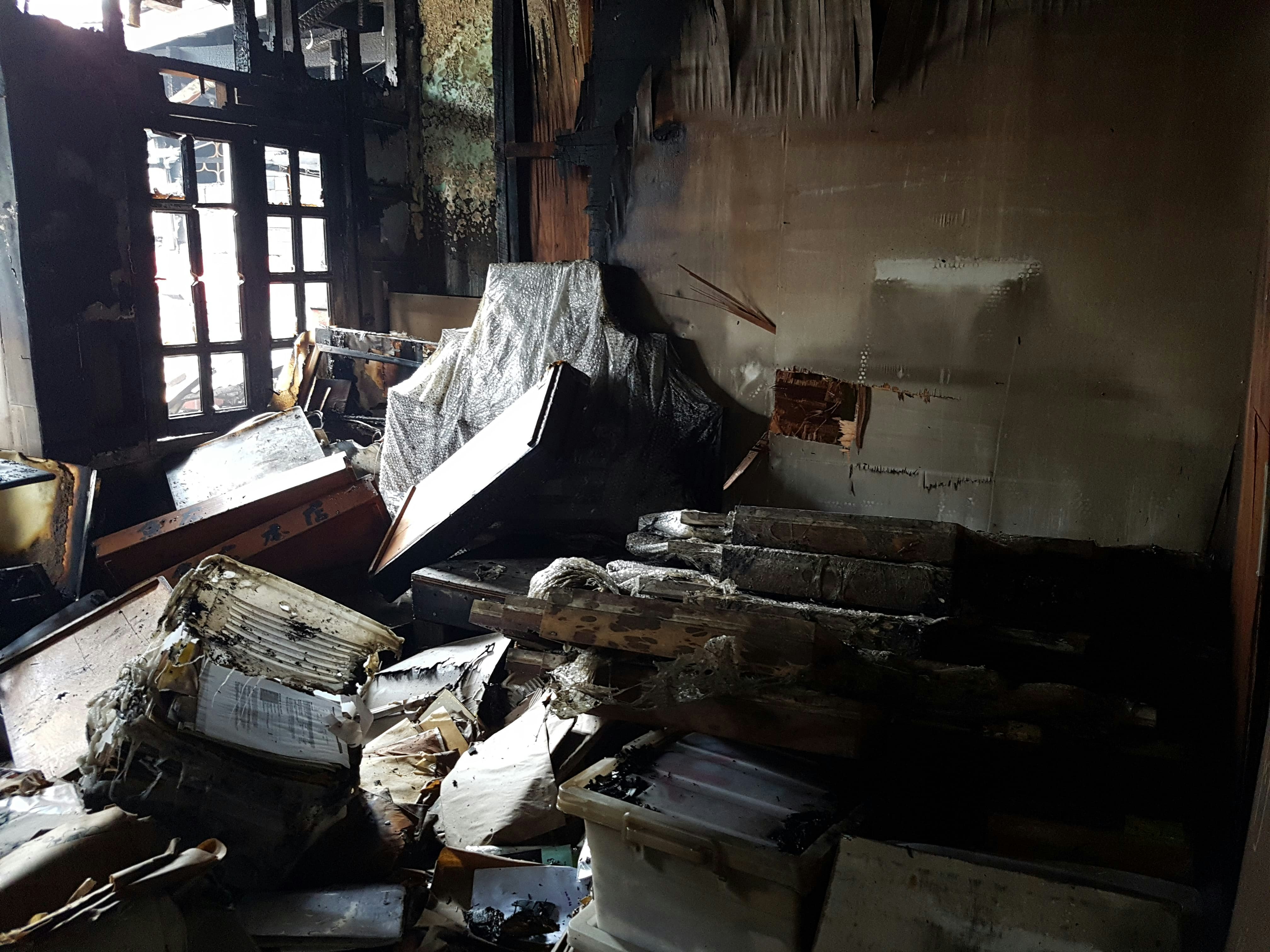
The back room of Papaya's former office in Kamunung, after the fire.
January
10 January. Papaya organised Sound as Growing, a talk by East German artist Antye Greie (a.k.a. AGF) on listening as a revolutionary gesture. This was followed by Kitchen Music, a collaborative project presented by HERESY and Kababae Mong Tao that tackled themes of kitchen work, food, and domesticity through sound, ritual, and performance.5 Sound as Growing would turn out to be the last talk held at Papaya’s Kamuning space.
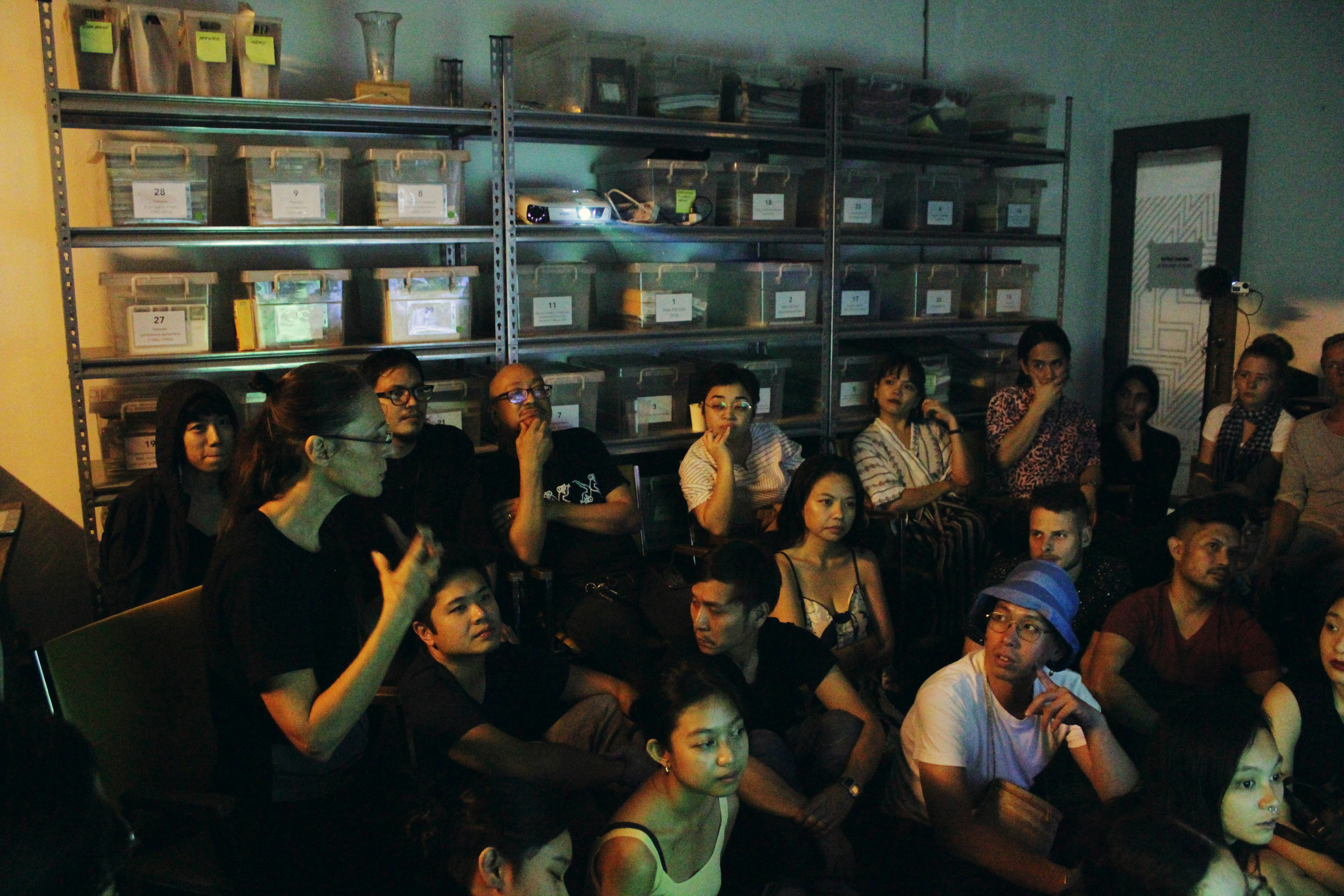
Sound as Growing, a talk by East German artist Antye Greie (a.k.a. AGF).
January
22 to 25 January. Papaya flew to Roxas City for the Jejak-Tabi Exchange (JTE), an exchange platform for contemporary performing artists in Asia to share, exchange, and explore critical ideas and practices in the framework of connecting two particular cities or contexts through a set of critical questions. Papaya co-curated and co-organised the Roxas City symposium and events leading up to the discussion in Okinawa. This edition of JTE explored the reverberation of colonial pasts in ongoing struggles and activism, and how they are articulated in theatre and performance.
In late January, Papaya’s Managing Editor Dominic Zinampan officially joined the team.
February
13 February. As part of the 3rd Kamias Triennial, Papaya organised what would turn out to be the last performance held at its Kamuning space: Atchara, an evening of fermented noises and moving sounds to engender communal listening, endurance, and impression.6
March
Following months of rumours and unease, the Philippines Government confirmed the first local transmission of COVID-19 in the country and, on 15 March, enforced strict quarantine measures in Metro Manila. This was initially planned to last only until 14 April. As of 24 July 2021, the total number of COVID-19 cases in the country is at 1,543,281 and, starting 25 July, Metro Manila reimposed a 10:00 pm - 4:00 am curfew amid a spike in cases caused by the Delta variant.
The team began to work remotely, with Facebook and Telegram group chats initiated for sharing COVID-19-related news, as well as articles on adjusting to the ‘new normal’. In retrospect, this was an early step in Papaya taking form as a collective unit. In the following months, more group threads were formed to focus on specific Papaya projects.
It was also around this time that it was becoming apparent to us that the 20th anniversary exhibition could no longer proceed. Events came to an abrupt stop, archiving was momentarily halted, and publications slowly progressed during this time.
April
April was a rather quiet month as we were all holding on individually, painfully adjusting to the quarantine and slowly realising—given the government’s demeanour—that it will take a much longer time for things to get remotely better.
May
1 May. Despite the increasingly bleak situation, we proceeded with commemorating Papaya’s 20th anniversary. Through Death is a Portal, a series of 20 black-and-white posters, we used the occasion to amplify calls for holding government officials accountable over their mishandling of the pandemic, the increasing militarisation of the countryside, and the escalating attacks on activists and critics. The series also marks the launch of Papaya's design campaign for its 20th anniversary, MMXX. 4The campaign would appear in subsequent Papaya materials for the rest of the year.7
7 May. Papaya launched the Throwback Thursday series of texts: a year-long project that sought to activate Papaya’s archives through personal recollections from both the Papaya team and the community around Papaya, along with documents and other archival materials. Both Throwback Thursday and Death is a Portal represent a shift in Papaya’s approach, wherein projects are situated primarily online.
Throwback Thursday on greenpapaya.art
June
3 June. Catch272, a bar in Quezon City, was getting ready to reopen as a takeout service. At around 10:39 am, Catch272 owner Apauls Tejada was just about to sleep after having repainted the floor all night, when she heard commotion from outside. She quickly exited the building to find that the second floor of the adjacent furniture store was engulfed in flames. Faulty electrical wiring was reportedly to blame.
The fire quickly spread to the backroom where most of Papaya’s archives were stored. Despite decimating the space, 70% of the materials narrowly survived the accident.
The news shocked Papaya’s community. We instantly received an outpouring of support in the form of heartfelt messages, generous donations, and offers to help in different capacities, from providing a new space in which we could store our materials to various proposals for fundraisers.
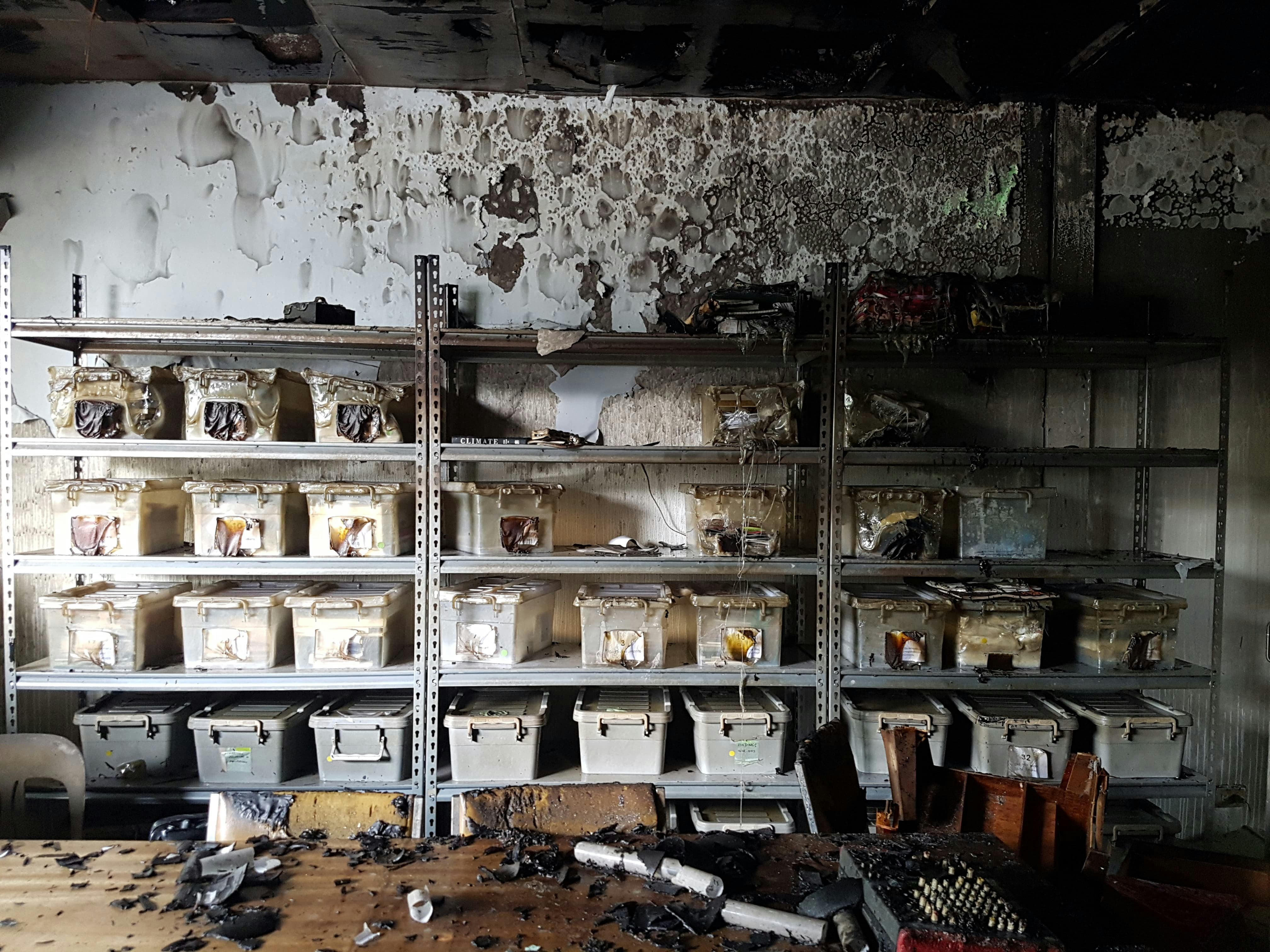
Papaya’s former office at Kamuning where most of our archival materials were stored.
6 June. Papaya began Fire Notes, a series of updates in the aftermath of the fire, discussing progress regarding relocation and the rehabilitation of the archives. Within a week after the fire, Papaya had published three of the five Fire Notes written so far.
12 June. On the Philippines’ 122nd Independence Day, the compilation album MAÑANITA: A Noise Barrage from 18 Bedrooms was released. Compiled by Papaya and PAWN Records, MAÑANITA was originally intended as a follow-up to VIS TRAX (2019), a two-volume anthology of noise and beats from the Visayas, but had shifted in tone in response to the worsening political climate.8
13 June. Archival materials from the garage at Papaya’s Rallos space were transported to the Lopez Museum and Library (LML) laboratory.
Shortly after the fire, Jel Suarez joined the Papaya team and helped salvage materials from the Kamuning space. These items were then temporarily stored at the Rallos garage to dry. However, the rainy season posed another threat to the materials already partially burnt and/or water damaged. There were initial plans to find a new space for Papaya and there had already been a couple of viable choices until the idea was discarded.
A few days after the fire, the LML reached out to Papaya and volunteered the use of their restoration laboratory, temporary archival facility, and technical expertise. Several Papaya members assisted the LML team in inventorying and drying the surviving items which took until early July. At this point, mould was quickly spreading, further threatening the materials. This—along with the ash and dust—caused minor outbreaks of rashes, migraines, colds, and other allergic reactions among the volunteers. In response, the LML jerry-rigged a fumigation chamber by modifying one of their spare rooms with trash bags and duct tape to accommodate the sheer volume of materials.
July
Aside from assisting LML’s rescue efforts, Papaya was occupied throughout July with developing project proposals and drafting applications to various grant-giving bodies.
27 July. To coincide with the President’s annual State of the Nation Address (SONA), Papaya co-organised SONIC SONA—an online noise barrage in protest of the administration’s crimes—with the Concerned Artists of the Philippines (CAP), DAKILA, and WSK Festival of the Recently Possible.
August
14 August. Just days after being notified by the Japan Foundation, Manila (JFM) that our project proposal was approved, Papaya launched Right People, Wrong Timing. In collaboration with Sau Bin Yap, we published a total of 23 texts every Friday, from 21 August to 25 December. The texts we presented include interviews, commissioned essays, and archival documents on defunct or dormant Asian arts initiatives that Papaya had either interacted with or had operated around a similar timeframe.9
22 August. After Papaya contacted W. Don Flores and Iris Ferrer—both of whom were part of the VIVA ExCon Capiz 2018 team—in late June regarding the resumption of editorial work on the VIVA ExCon 2018 catalogue, the publication’s editorial team regrouped and had a six-hour online meeting. It was also around this time that fire-damaged moving image works in Papaya’s possession were shipped to Vancouver after Papaya received an offer from media archive initiative Recollective to help restore the materials.
September
9 to 26 September. Papaya co-organised the second edition of Light Leaks—a collaborative program between Papaya and Los Otros—titled Enactment and Evidence. Co-presented with MCAD Platforms, Enactment and Evidence aimed to “[highlight] the difference offered by recorded documentation and oral history in the appreciation of performance art and moving image.”10
19 to 28 September. Papaya co-presented with IBON Foundation a screening of Beyond the Walls of Prison, a 1987 documentary by the AsiaVisions film collective on life within and beyond prison walls during the Marcos dictatorship, for the 7th Active Vista International Human Rights Festival.11 This was followed by a discussion titled Beyond Forgetting: Conversations on Memory-Keeping and Social Justice on 22 September.12
Around mid-September, Papaya received an email from the Goethe-Institut approving our application for the International 2020 Relief Fund for Organisations in Culture and Education (Hilfsfonds)13. Aimed at recovering the archives and resuming archival work after the fire, the grant enabled us to re-establish our office and archives facility. The funding also helped us to continue with the digitisation of archival materials as well as develop online platforms designed to broaden the accessibility of knowledge and resources to our community and a greater public amidst the global pandemic. Tao Aves from Catch272 temporarily joined Papaya as our accountant to assist in managing this grant.
In late September, office IDs were produced, somehow formalising the sense that Papaya was a team, with each member having official role titles.14
October
During this month, the archives were transferred back to Rallos from LML. The following weeks were devoted to cataloguing, restoring, and digitising the returned materials.15
November
In early November, Merv Espina, Papaya’s Project Manager since 2013, left the team. Soon after, Iris Ferrer officially joined the team.16
Throughout November, archival materials brought back to Rallos from LML were cleaned and inventoried.17 An Archives Cleaning Manual was produced to guide the team in handling them. Shortly after, photographer Kiko Nuñez joined Papaya and started helping with the digitisation of artworks from the archives.
December
3 December. Papaya appeared on ArtReview’s Power 100, an annual list of "the most influential people in the contemporary artworld." Peewee devoted a Throwback Thursday text to commemorate the event.
4 December. The Papaya Shop Instagram account was officially launched.18 Among the first items made available were the Death is a Portal series in zine format; the assemblages of Ramie “Apid” Jiloca, Papaya’s studio assistant since 2000, as well as several collages from Peewee; and three 20th anniversary posters commissioned from Ginoe, Rox Lee, and Dina Gadia.19
20 December. With the help of the Hilfsfonds grant, we were able to design and officially launch the Papaya website.20 Ten days after this, a wiki for VIVA ExCon: The Community Archives Project was also made public. An “edit-a-thon” was held for the latter on 14 March 2021.
Many of the projects initiated last year carried over to the first quarter of 2021. From January to February, we were occupied with finalising paperwork for the Right People, Wrong Timing project and the Hilfsfonds grant. Other projects that have been going on for the past few years, like the VIVA ExCon publications and website, likewise carried over and were due to be completed within the first half of the year. Papaya continued to raise funds through the Papaya Shop (up until June when it had to be put on hold due to insufficient manpower) and participate in events like the live selling event and fundraiser21 South South Veza last 3 February. On the same day, phase 1 of the Papaya archives was made accessible on the AAA website. Since then, condition reports of the archives continue to be drafted and materials are still undergoing digitisation.
We have also been hard at work preparing for our participation in several international events, as well as a local exhibition, most of which were initially scheduled some time in the latter half of 2021 but have since been moved to 2022. Additionally, we are also in the process of developing new projects: in January, we announced the discussion series Shri Vishayas: Intersections of Indigenous, Rural, and Contemporary Cultures and, currently, we have been actively participating in the Transnational Coalition for the Arts (Transnation), an international artists alliance in solidarity with the people of Myanmar.
The special circumstances of the previous year have left indelible imprints on the organisation, inducing severe shifts in our operations, methods, and approaches. Prior to 2020, Papaya operated more or less as a core group of three to five people with several assistants and a fluctuating network of collaborators and volunteers per project.
Papaya’s size grew in the past year as former regulars and volunteers entered the team, most of whom joined in response to certain crises and emergencies.
Papaya gradually transformed into a fixed team with each member having a designated role.22 The new sense of Papaya being a “collective,” or more accurately, a handful of project- or task-specific pockets (e.g. archiving, editorial work, post-fire donation drives, Papaya Shop, etc.) working simultaneously and often overlapping, resulted in a relatively less centralised setup. Members communicated better and a more efficient workflow had been developed. This renewed focus on online activity also allowed us to more fully utilise our existing digital platforms like social media, cloud storage, and various Google applications.
Like many people, we directed our attention to our online platforms. This seemed pertinent considering physical gatherings are prohibited to this day (largely due to the administration’s severely bungled response to the pandemic), not to mention Papaya being rendered spaceless by the fire. In lieu of the characteristic informal and intimate atmosphere of past Papaya events,23 we decided to amplify our social media presence by engaging our community via regular postings, motivated as well by the desire to activate our archives and make our materials more accessible.
It would be wrong not to mention the invaluable help that we received from our community and the tremendous support extended to us by friends, strangers, and institutions amidst a difficult year for everybody, without which the painful circumstances would most likely have forced our closure much earlier than anticipated. Although things continue to be uncertain, what is certain is that Papaya won’t close in 2021, largely thanks to our community’s support. 24
Authors: Yuji de Torres, Iris Ferrer, Norberto Roldan, Touki Roldan, Jel Suarez, and Dominic Zinampan
Editor's Note: Green Papaya continues to accept donations to support their conservation work and rebuild archive facilities. Click here for information or if you'd like to offer support.
Notes
- Papaya's first location was a cramped third floor unit along Maginhawa Street in Teachers Village, Quezon City. In 2001, we relocated Papaya to a long garage space 50 metres down the same street.
- Artist Lesley-Anne Cao officially joined the team during this time, working primarily as Project Researcher on the Papaya archives. A year prior, Lesley assisted Papaya’s former Program Director Merv Espina with the archives of artist Rox Lee in preparation for the “Misfits”: Pages from a loose-leaf modernity (2017) exhibition at the Haus der Kulturen der Welt (HKW). At around the same time, Yuji de Torres interned for Papaya as part of his academic requirements. He continued to help document Papaya events in the years since and has now become Papaya’s Technical and Media Manager.
- The frequent postponement does not indicate Papaya reneging on its decision to close; Papaya is determined to close although the exact date remains unclear.
- MMXX was commissioned to TOFU Projects, a design studio co-founded by Touki Roldan.
- Kitchen Music featured artists Bohovee, Sister Joyce, Teenage Granny, and Twista Sista, with live visuals by Ch3x.
- Atchara featured Raven Chacon, Miko Revereza, and Elisa Ferrari in collaboration with Christian Vistan and Gabi Dao. The event title comes from a pickled condiment made from green papaya.
- The first four Death is a Portal posters were published on Papaya’s social media platforms on 1 May, with following editions being published throughout the month. On 4 June, Papaya published several red posters executed in a similar vein as the Death is a Portal series. Among the subjects addressed in the posters include the shutdown of ABS-CBN, one of the country’s major broadcasting networks; the railroading of the Anti-Terror Bill (see note 7); and controversial statements made by the Inter-Agency Task Force for Emerging Infectious Diseases (IATF-EID).Throughout the next few months, similar posters were published sporadically, e.g. to respond to the killing of human rights activist Zara Alvarez, to express solidarity with the Peasant Movement of the Philippines (KMP) during the International Day of Action Against Peasant Killings, and to amplify donation drives in the aftermath of Typhoon Ulysses.
- On 3 June, the Anti-Terrorism Bill (now Republic Act No. 11479) was approved on final reading. With its loose definition of terrorism allowing suspected “terrorists” to be detained without an arrest warrant, many perceive this as the administration’s tool to crack down on activists. The album’s release coincided with nationwide protest rallies wherein among the strongest demands of the protestors was to junk said bill. These protests were similarly referred to as mañanitas, a jab at the controversial birthday celebration of then-Philippine National Police (PNP) chief Gen. Debold Sinas—photos of which had surfaced, showing dozens of police officers violating the ban on liquor and mass gatherings as per quarantine protocol, the same measures that they had been harshly enforcing. This was pathetically defended as “not a party” but a “mañanita”.
- After being notified of the JFM grant, Papaya began discussing with Sau Bin in late June regarding a possible expansion of the Throwback Thursday series that would encompass various arts initiatives around Asia. This eventually developed into Right People, Wrong Timing.
- This edition featured works from Lena Cobangbang, Katya Guerrero, and Jean Marie Syjuco, plus discussions with Eileen Legaspi-Ramirez, Cocoy Lumbao, and Clarissa Chikiamco.
- Active Vista is an annual event organized by the artist collective DAKILA, typically scheduled during the week of the Martial Law Anniversary (21 September).
- The discussion featured professors Rosemarie O. Roque, Lyra Buenrostro-Cabbab, and Mary Grace Concepcion, with Jun Sabayton as moderator.
- Papaya received an invitation from the Goethe-Institut to apply for the grant around late June.
- This was in response to the Quezon City government’s policy that residents are required to present either a quarantine pass or a company ID to enter commercial buildings, markets, and shopping centres.
- Papaya began renovating the Rallos space in September to accommodate the fire-damaged materials returning from the LML.
- Iris first worked with Papaya in 2010, as an intern for Project Immemorial. She would occasionally help Papaya with other projects, like VIVA ExCon and the Southeast Asian Art Residencies Meeting (SEAARM), both in 2018.
- The team that handled the archival materials included Papaya members Jel Suarez, Joaquin Roldan, and Apid Jiloca, and volunteers Sara Rivera, Kat Medina, Wilma Jiloca, Joemari Burce, and Kenneth Paras.
- Papaya Shop and its design identity began to be conceptualised in October 2020. Aside from being a fundraising effort, we wanted our shop to, in some ways, activate our archive. For example, we wanted our series of commemorative posters (see note 18) to feature artists who had worked with us in the past. We hope that these new interactions could serve as entry points for others to explore how these relationships were formed and to learn more about the projects where we had collaborated with the invited artists before.
- Production for the posters began in November. Young and emerging, mid-career, and senior artists based in the Philippines and elsewhere, who in various capacities have worked with Papaya in the past, were commissioned to come up with designs. At the time of writing, the series featured artists Ginoe, Dina Gadia, Rox Lee, Wyndelle Remonde, Amy Lien and Enzo Camacho, and Wesley Valenzuela. Papaya is working on completing a series of 20 posters.
- Papaya’s former domain and website (greenpapayaartprojects.org) has long expired and plans to create an updated website have been in the pipeline since 2016. We began to develop and design our own website using the Cargo Site platform in September.
- The other beneficiaries are Raw Material Company (Senegal) and Casa do Povo (Brazil).
- At the time of writing the first draft, Papaya was composed of Lesley-Anne Cao, Yuji de Torres, Iris Ferrer, Ramie “Apid” Jiloca, Kiko Nuñez, Joaquin Roldan, Norberto “Peewee” Roldan, Touki Roldan, Jel Suarez, and Dominic Zinampan. In June 2021, as various members began focusing on personal projects and other commitments, Papaya ceased being a fixed team, and instead returned to a project-based setup.
- Papaya’s venues have always had a domestic ambience: our first space was a condo unit followed by a house (both along Maginhawa Street) before moving to another house in Kamuning (later turned into a bar and office/storage). The living room and garage at the Rallos house—or “Green Papaya Extension”—was also used as a venue for talks, screenings, and afterparties.
- This essay shares the same title with an earlier Throwback Thursday post published 15 days after the fire. The brief text accompanying the photos concludes with: “The Kamuning district, by the way, was named as such because it used to be dotted by these small trees (Murraya paniculata) endemic to Southeast Asia. Hardly any tree is left today.
About the contributor
Green Papaya Art Projects is an artist-run initiative that supports, organises and explores alternative approaches to art. Authors: Yuji de Torres, Iris Ferrer, Norberto Roldan, Touki Roldan, Jel Suarez, Dominic Zinampan.
